








As an Oculoplastic surgeo Dr.Zwick received advance trainingincosmeticand reconstructive surger yofth structures surroundingthe eye. He is oneofless than hundred surgeons worldwi to complete afullfellowshi devotedentirely to eyelid a orbital surger y. Patients fee confident knowingthatthe surgeon possesses such expertise.

*Results shownare actual pati of Dr.Zwick.
















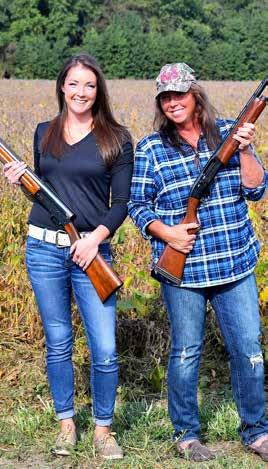



TASTE BUDS
“Deep Dish Duck” and a boozy drink
HEARTHBEAT
Elegant outdoor entertaining this fall
WAYFARING
Bombay Hook National Wildlife Refuge LOCAL
Pan-seared rockfish
Aerial yoga at The Studio
Hester Sachse of Church Hill Theatre
GUN SHY
Tips for novice shooters
HIGH SPIRITS
Charm City Meadworks
PROFILES
Families hunt together across the Shore
THROUGH THE LENS
The best of local photography
SHOP TALK
Antiques and accessories for fall
The Kennedy family
Each issue, Shore Monthly will offer exciting features for your enjoyment. You’ll find articles about everything from mouthwatering culinary delights, to road trip adventures, music, and the arts — and more!
THE HEARTHBEAT
An inside look at some of the area’s most unique homes, gardens, and remodels.
LOCAL FLAVORS
Delicious recipes from around the region.
TASTE BUDS
Foods and drinks, that when served together, form perfect complementary pairs.
THROUGH THE LENS
Local photographers share their best photos from around the region.
WAYFAIRING
We explore unique destinations that are just a car ride away.
HIGH SPIRITS
Local libations and the places that serve them.
PROFILE
Delving into the lives and stories of local characters from around the Shore.
STAGE LEFT
A spotlight of local musicians and arts in the area.
BE WELL
Healthy living and serenity on the Shore.


Fall is a special time on the Eastern Shore. Waking up to the sounds of Canada geese migrating north along the Atlantic Flyway; gathering with family and friends for deer or waterfowl hunting trips; cooler temperatures; fresh, local oysters; the aroma of your favorite pie baking in the oven for Thanksgiving supper; stoking the first fire of the season; pumpkins; mums; apple picking; the Waterfowl Festival; and warm sweaters. These are all reasons fall on the Shore is so special.
Whatever your favorite part of fall may be, one thing is certain — it is the time of year most of us are able to relive cherished memories with grandparents during the holidays, pass on family traditions to new generations, or remember your favorite hunting trip with a parent.
Hunting is a huge part of who we are on the Shore, and families throughout the Mid-Shore have been passing those traditions down for generations. That’s why we’ve chosen to tell those stories in this edition of Shore Monthly , and we hope, through reading those stories, you’ll be reminded of those memories you hold most dear of your own family during this time of year.
Katie Willis Editor Shore Monthly
In October’s edition of Shore Monthly, the website associated with the feature titled “Medicine Woman,” about local herbalist Deborah Mizeur, was incorrect. The correct website is www.deborahmizeur.com.

EDITOR
Katie Willis
CREATIVE DIRECTOR
Greg Mueller
CONTRIBUTING PHOTOGRAPHERS
Christopher Watson
Allison Zaucha
Coty Jones-Hardy Henley Moore
Diving Dog Creative
Elizabeth Fogarty
Caroline Phillips
Greg Sharp
CONTRIBUTING WRITERS
Bethany Ziegler
Denae Spiering
Connie Connolly
Michael Davis
Sarah Ensor
Greg Sharp
Josh Bollinger
EDITORIAL
PRESIDENT/PUBLISHER
David Fike
MARKETING DIRECTOR
Betsy Griffin
NEW MEDIA MANAGER
Paul Hagood
ACCOUNT EXECUTIVES
Gail Ruppe
Jon Ekroos
SOCIAL MEDIA COORDINATOR
Jessica Stenzel
ADVERTISING CONTACT
443.239.0307
SUBSCRIPTIONS 410.770.4005
SUBMISSIONS submissions@ shoremonthly.com









The Mattress Store has filled your families’ bedding needs since 1982. They stand behind “The Mattress Store Promise” NO Fast talking, High Pressure Sales Talk in this store. We value the time you spend with us andwestrive to provide the highest standard of service at the lowest price



EASTON WATERFRONT ESTATE:Rarefi nd, prominentpoint of land on theTredAvon River. Updated center hall Colonial with guest/ pool house, watersidepool, many original wood details andlarge barn.Pier,boatshed& sandybeach.Sunsetviews. Includes additionalwaterfrontbuildinglot $2,950,000

TRAPPEWATERFRONT:Priv ately located on gorgeous6+ acre waterfront lotoffering fabulous screened porch, family room with fireplace, secondfloor master andfinished basement with bar, bath &livingspace.Pier with 4’ MLWand gorgeousviews.Excellentfishingand hunting! $775,000

OXFORD CAPE: Completely renov ated,tastefully decorated andwell-appointed3 bedroomCapeinpopularOxfordwaterfrontcommunity. Breezy screenedporch,kitchen with top of thelineappliances, first floor bedroomand bath.Country locationclose to downtownOxfordand Easton. $425,000



PRIME EASTON LOCATION: Lovely Eastern Shorehome tucked away on 4+ acresoverlookingthe protecteddeep watersofSnugHarbor. Minutes by carorboattoOxford. Spaciousgreatroomwith FP, bright &openremodeled kitchen. Riverroomoverlooking waterside pool. $1,335,000

ST.MICHAELSWATER ACCESS: Bring your boat! Deep water! Up to date,openfloor plan St.Michaelshomewithwater views, gourmetkitchen,two fireplaces, first floormasterand reardeck. Shared ownership of waterfront lot with deep water boat slip andpavilion $649,000

EASTON COLONIAL: Nicely maintained4/5 bedroomhome, only minutes to downtown. Beautifully manicuredgrounds, fencedrearyardwithdeck& shed.Insideoffers formal living / dining,hugefamily room with pellet stove,firstfloor bedroom/office &spacioussecondfloor owner’ssuite. $348,500
(OFFICE)410-822-1415


EASTON /OXFORDWATERFRONT: Beautifullyrenovated waterfront home in popularneighborhood closetodowntownEaston& Oxford.Watersidepool, pier,and nice mature trees. Fabulous river room,gorgeousgourmet kitchen and spaciousowner’ssuite with topofthe line bath $895,000

EASTON COUNTRY LIVING: Gorgeouscountry setting minutestodowntown. S3+acres offeringlarge kitchen,huge master suitewithsitting area,WIC andbath. Third floor bonus room.Detached outbuildingwithlarge recreationroom. Several outbuildings andswimspa.Norestrictions. $455,500

EASTON COLONIAL: Well-maintained 4bedroomhomein Charlestown Village offersfencedrearyardwithshaded deck, bright andopenfloorplan, formal livingand dining rooms, spaciousfamily room,hugeowner’ssuite with twowalkin closetsand largeattic space. Communitypool. $339,900



“You come to the Eastern Shore, you’ve got to try duck.”
Story by Bethany Ziegler | Photos by Henley Moore
Those wise words come straight from the mouth of Daniel Pochron, executive chef of the Tidewater Inn and its Hunters Tavern restaurant, located in the heart of downtown Easton. And Pochron, along with Executive Sous Chef Matthew Robbins, has created a dish to help you do just that — something he’s named “Deep Dish Duck.”
For those who’ve historically stuck with chicken over duck, Pochron says it’s time to branch out, and this is a mild enough dish to ease you in. It’s also one that honors its home, with the Tidewater Inn serving as a hunting lodge of sorts when it opened in 1949.
At that time, ducks would’ve been cleaned on site, making this an ideal location for either a first or a return taste of the bird.




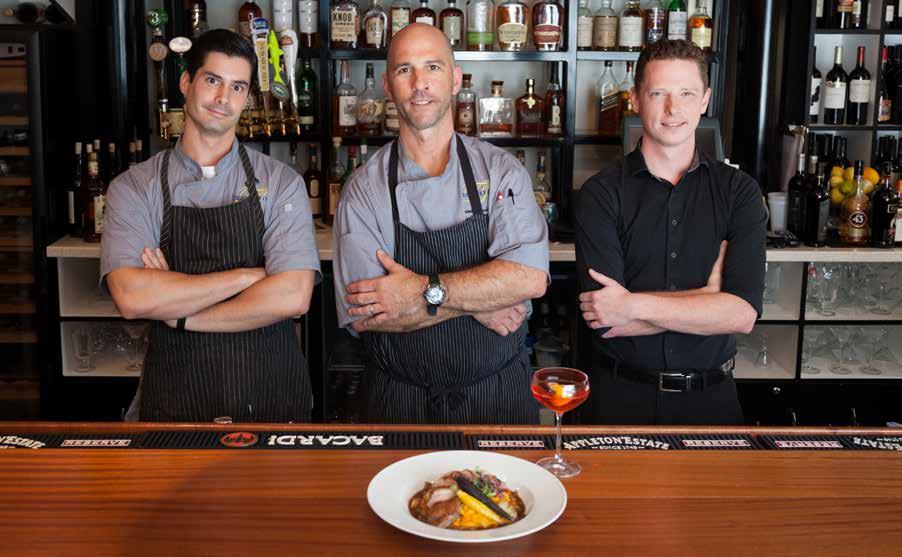
Inspired by fall flavors and Eastern Shore traditions, this dish features a roasted duck breast on top of a sweet potato purée, with a duck confit shepherd’s pie underneath, as well as roasted turnips, celery, butternut squash and cipollini onions.
Served in layers on a single plate, “Deep Dish Duck” looks deceptively overwhelming at first glance. Once you dive in, you realize it’s just enough to fill your belly without overdoing it. And between the succulent duck and the rich fall vegetables, it’s a dish that feels like the perfect mix of fine dining and comfort food.
The duck confit suits the Tidewater’s upscale venue while the sweet potatoes give you a taste of the familiar — and their pairing leaves you delightfully satisfied.
Speaking of pairings, no good meal would be complete without a complementary cocktail, especially for those seeking to warm up on a brisk

It’s a dish that feels like the perfect mix of fine dining and comfort food
November day. This is where a third member of the Tidewater’s team, bartender Richard “Buck” Willey, steps in with his creation — “Plume of the Quill.”
This cocktail isn’t for everyone. Willey describes it as “very boozy” — and he’s not exaggerating. It’s made up of equal parts gin, Campari and sweet vermouth, and it’s finished off with a dash of absinthe, a splash of Prosecco, and an orange twist.
“Plume of the Quill” feels like a classic cocktail with a fun, fall twist. It’s incredibly flavorful with an almost licorice taste, but the Prosecco goes a long way to break up the stiffer alcohols. It’s also visually appealing, with a warm,
inviting color that may leave fellow patrons eyeing your drink from across the room.
Despite, or maybe because of, its strength, the drink pairs well with its duck counterpart, and could stand up to other hearty meals, particularly those featuring roasted meats.
The staff at Hunter’s Tavern emphasize their teamwork, and this drink seems to have gotten the memo.
“Deep Dish Duck” and “Plume of the Quill” are a duo that screams fall, and not just because of their waterfowl-themed names. The savory combination will leave you warm on the inside and smiling on the outside as you head back outside to face cooler temperatures and crisp air. S
















At Integrace, we know thatyour age does not defineyou. So we’ve created afamily of life plan communitieswhere you can connect with your passionsand discover new paths every day. And with activecampuses in Maryland’s most charming destination towns—plus gorgeous housing options and afull suite of servicestosupport you everystep of the way—you’ll find everything you need to live the life that’s most meaningful to you. Visit Integrace.org to discover all the possibilities that awaityou



Story by Connie Connolly
WWhen the air turns cooler and the leaves turn colors, it’s time to get outside and enjoy yet another reason to savor life on the Shore.
The hot, hazy, humid days of summer giving way to crisp, drier autumn days and nights may inspire you to spend more time outdoors relaxing and entertaining.
While many entertain with traditional barbecues, orange pumpkins, and mums, or beverages set out in coolers and buckets, consider adding new entertainment elements and decorations to your outdoor Shore space this season.


Staying warm when the temperature drops is important. “One of the easiest updates you can create for your outdoor space is a fire pit,” said Brad McCready, vice president of McCready’s Hearth & Home in Cambridge.
“The easiest option is to purchase a ‘plug and play’ gas fire pit at your local retailer,” McCready said. “Many prefer gas because startup is easy and you can simply turn it off when you are done. However, a DIY fire pit project is quite easy and inexpensive. By creating your own, you can make it the size you desire and give it a look that coordinates with the exterior of your home.”


“Fire tables or outdoor coffee-type tables with a gas burner have become very popular,” McCready said. “Finishes can be anything from reclaimed wood to stone, or many metal finishes are available. Many of these units are portable. In most cases, they hide a grill-sized propane tank under the table for ease of mobility.”
“Outdoor space heaters will help keep the fall chill away,” McCready said. “These come in a variety of shapes, styles, and prices, so finding the right one is rarely an issue. Because they are propane fueled, they are easy to clean and operate.”
If you love the fragrance of wood smoke, however, an outdoor fireplace
ABOVE: Consider adding new entertainment elements to your outdoor Shore space this fall.
Photos by Diving Dog Creative.
An apple cider bar and fallinspired desserts, presented with warmer hues, will spice up your autumn event.






could be the solution for you. Make sure you consider the surrounding space and open air when placing your fireplace, so smoke travels away from your guests and not home in their clothing, McCready said.
“A ribbon fireplace adds heat with some modern flare, as well,” he said.
And there’s no need to put away your planters just yet. Try adding winter color with Lenten Roses, Winterberries, and creeping thyme. Gold and red-berried Bittersweet can be found growing wild on some areas of the Shore.
Ken Morgan, owner of Robin’s Nest Floral and Garden Center in Easton, suggested removing tired summer plants and adding fall ornamental grasses, cabbages, kale, sedum, asters, and even late-blooming Black-Eyed Susans. Tuck in some hardy pansies for color through the fall and into the spring.
McCready suggested putting out simple antique pottery crocks filled with autumn leaves, dried hydrangeas, and berries, or adding a rustic bowl of pine cones and birch tea light holders.
“Don’t shy away from incorporating fall foliage into your flower arrangements,” said Carolyn Lasako, studio manager at Kari Rider Events in Easton. “The texture really adds a nice pop.”
And with the sun setting earlier, “you want to make sure your outdoor space is well-lit — you don’t want to skimp in that department,” Lasako said. “We love string lights, but you can also add an outdoor chandelier.”
Lights add charm as they dance and reflect off of gold and copper metallic tones in lanterns, coffee table trays, glassware, charger plates, and Moscow Mule mugs, which work well with neutral-toned textiles.
“We’re bringing in more masculine hues, like black flatware and candles to balance out the warmer hues,” Lasako said. “One of our favorite things to do is set up an outdoor bar cart or apple cider bar,”
For an apple cider bar, Lasako said you can add different types of cider, rum, bourbon, and all kinds of garnishes. Orange pumpkins and gourds have made way for white pumpkins or pumpkins in shades of jade, Lasako said. She said Councell Farms has a good collection for those who are pumpkin hunting this year.
You want to make sure your outdoor space is well-lit — you don’t want to skimp in that department S
Wine from the many Eastern Shore wineries can add local flair and flavor to your entertaining, and local craft beers or pumpkin ales can be poured into small “flights” for tasting parties.
As for providing food for your guests, McCready suggests keeping it all outside this year.
“Fall is the perfect season for grilling,” McCready said. “Consider installing an outdoor kitchen on your patio or lanai, complete with grill, sink, and refrigerator. Keeping the mess — and guests — outside is worth the investment alone.”
Also, “pack up those summery cushions and pillows, and switch up to the warmth of autumn colors and textures,” McCready said. “Lay down a coordinating outdoor rug. For a little more coziness, bring out some lap throws, blankets, and pillows so you can enjoy the fresh air when the temperature drops.”
So, whether you live inland or on the water, with a bit of planning you can enjoy the cooler days of autumn and entertain with Shore warmth and beauty — and a touch of elegance.

Those of us who arewarm and dry and safe and well fed must show up for those who are cold and wet and endangered and hungry.
That’sa rule of life.
Every ethical and religious and spiritual tradition in the world agrees on that rule.
Elizabeth Gilbert
Artist: Elias Izoli

Benson &MangoldMangold@Bensonandmangold.com,ChesapeakeHearing Centers, McCrone, IncreteofMaryland, Inc.,Bay Times, Miltec, Lundberg Builders, BayviewPortraitsbyCindyWilliams Sigmon, Heming way’s, Prospect BayCountryClub, SalonAtelier,MaidHealthy,SafeAtHome SeniorCare,TheArtcademy, Construction Services&Supply, Inc.,Railway Title, The NarrowsRestaurant, RileyCustomHomes&Renovations, FreeState&Son,KentIslandHolidayInn Express, PenFed Credit Unionkara.plummer@penfed.org, Harris Crabhouse, Roof Center,IslandFurnitureStudio, The AspenInstitute WyeRiver Conference Center
stepping up to support, feed, clothe and
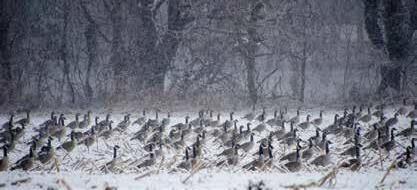







The path to Bombay National Wildlife Refuge in Smyrna, Del., cuts through fields and fields of a variety of agriculture. Brightly colored, handmade, wooden signs flank the sides of state Route 42, most selling fresh fruits and vegetables, which this time of year include offerings of potatoes and pumpkins.
The trip from Easton to the tidal salt marsh hideaway in Smyrna is just under an hour and 20 minutes, with hardly any traffic. It’s only a few turns to the wildlife refuge once you get off U.S. Route 301, pass
through Sudlersville and travel over the state line into Smyrna, — home to a designated wetland of importance by the Ramsar Convention.
According to the United States Fish and Wildlife Service, Bombay Hook is one of more than 560 national wildlife refuges in the United States, encompassing more than 850 million acres of land and water. Delaware has only one other national wildlife refugee in addition to Bombay Hook — Prime Hook National Wildlife Refuge in Milton.

The Atlantic Flyway, one of four major migratory paths for birds — the others being the Pacific, Central and Mississippi flyways — stretches the entire U.S. East Coast, and further north and south.
Bombay Hook was established in 1937, with the goal of maintaining a breeding ground for migrating birds. According to the FWS, Bombay Hook encompasses 16,251 acres of tidal salt marsh land. Though the land was established as a national wildlife refuge in the late 1930s, its history dates back to 1679, when the Kahansink Native Americans sold the property to New Yorker Peter Bayard. The refuge gets its name from the Dutch words “Bompies Hoeck,” which according to FWS, means “little-tree point.”
After the wildlife property was established as a refuge, construction projects helped Bombay Hook become a respite for migrating waterfowl and
shorebirds. The construction was carried out by an African-American Civilian Conservation Corps company, according to FWS. Projects included water control structures, which today are manipulated for food purposes, and aided in the formation of various pools on the property.
With the passage of the National Wildlife Refuge System Improvement Act in 1997, refuge systems made it a priority to create recreational wildlife activities.
What started at the refuge about 80 years ago with a single observation tower 90 feet high, since has turned into three observation towers, each 30 feet high, stemming from its five trails. Traveling around the 12-mile Wildlife Drive loop by car, the Bear Swamp, Parson Point, Boardwalk, Raymond Tower and Shearness Tower trails all are accessible from the roadway. The path distances range from a
In addition to wildlife viewing opportunities, Bombay Hook is known for its available hunting locations during the regulated seasons for deer, turkey, small game, and waterfowl, using a shotgun, muzzleloader, or bow.
Four areas are designated for game hunting — Steamboat Landing, South Upland, Regular/ Fisher, and Headquarters — and four locations for waterfowl hunting — West Waterfowl, Snow Goose Hunt, South Waterfowl, and South Upland areas.
Information about available dates to hunt are listed on Bombay Hook’s website under “Visitor Activities,” and specific hunting rules regarding fees
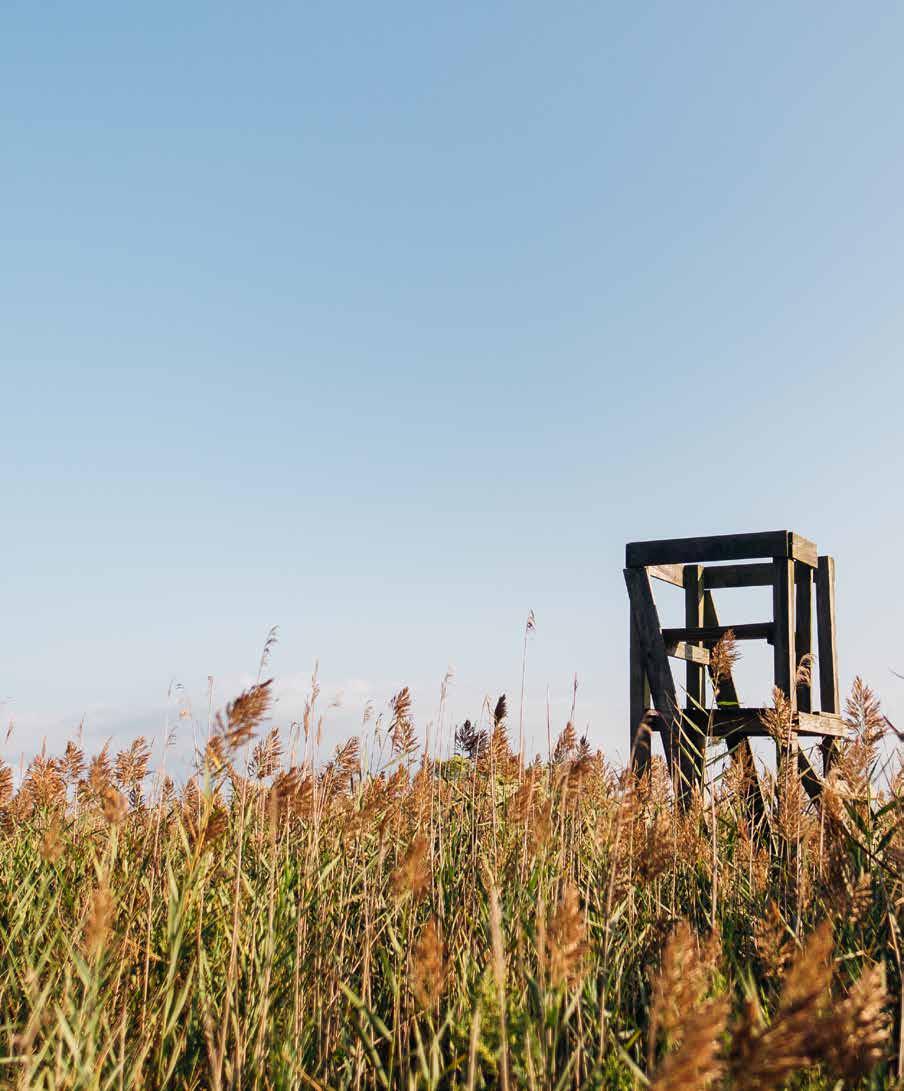
and applications can be found on the website, as well.
A special youth hunt is scheduled for Nov. 4 on Steamboat Landing and Fisher tracts. Individuals will be selected using a standby ticket lottery drawn an hour and a half prior to the allowed time to hunt. Another waterfowl youth hunting day will be held on Feb. 10.
Statewide deer hunting dates are: Sept. 1 to Jan. 31, archery and crossbow; Jan. 22 to 27, muzzleloader; Nov. 10 to 19 and Jan. 13 to 20, shotgun; Dec. 9 to 16, special antler-less; and Jan. 6 to 13, handgun.
Statewide duck hunting dates are: Oct. 27 to Nov. 7, Nov. 20 to Nov. 25,
and Dec. 8 to Jan. 27, with a daily bag limit of six.
Reed said although waterfowl hunting takes place in areas away from the Wildlife Drive loop, deer hunting does occur in areas accessible by the road. For safety measures, viewing is sectioned off during hunting days, near the headquarters and road, so people don’t get hurt. The refuge still is open during those dates, only with limited viewing for those who aren’t hunting, Reed said.
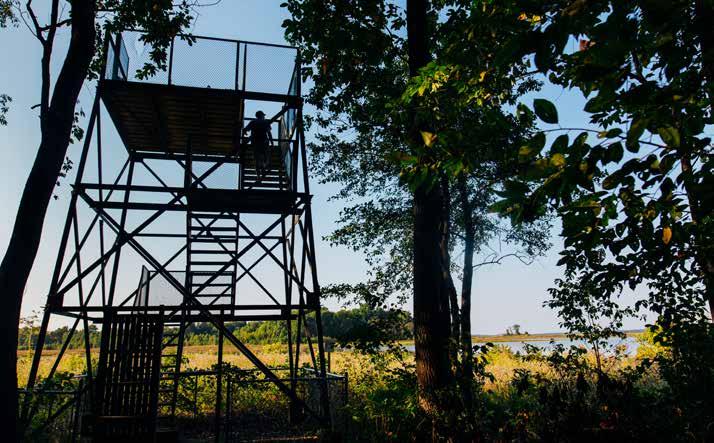
quarter of a mile to a full mile round trip.
Oscar Reed, refuge manager, said some of the best views of the refuge can be taken in from the seat of a car. He said senior centers and other organizations often bring their clients out because of the handicap accessible trails and the amount of viewing available without stepping out of the vehicle.
Some of the fall waterfowl seen on the refuge include the wood, ruddy, American black, and hooded merganser ducks, as well as the snow goose, northern shoveler, and northern pintails. Great egrets, blue herons, and snowy egrets wade in the waters year round, Reed said. During the spring months, when the shorebirds come around, black-necked stilts, greater yellowlegs, and black-bellied plovers can be found throughout the area.
To see the various wildlife species, drivers park along the Wildlife Drive loop, binoculars in hand, and peer out over the Shearness and Raymond pools. Waiting and watching, visitors move around the property observing the colors,
sounds, and sights of the feathered figures backdropped with tall marsh grasses jetting out of the shallow waters swaying with the wind. Sight lines go for miles.
Reed said being close to larger cities affords visitors the chance to get away and disconnect from a busy world.
The entrance fee is $4 per vehicle, per day. Annual passes, such as the Federal Duck Stamp, the Bombay Hook Pass, or Interagency Annual Pass are long-term options for park viewing. A yearly pass at Bombay Hook is $12. Active duty personnel and their families can receive a free Interagency Annual Pass, and there are discounted senior options for those 62 and older.
The refuge’s website includes a calendar of events, which includes monarch tagging, lessons about insects, and guided tours of the refuge. Photographers, wildlife enthusiasts, and hunters alike can find a day’s worth of activities at Bombay Hook National Wildlife Refuge.
“It’s really a nice place to come and relax, and wind down, and just kind of slow your clocks down a bit,” Reed said.
was established in 1937, with the goal of creating a breeding ground for migrating birds. The Atlantic Flyway stretches the entire U.S. East Coast, and further north into Canada and south into Central America. S
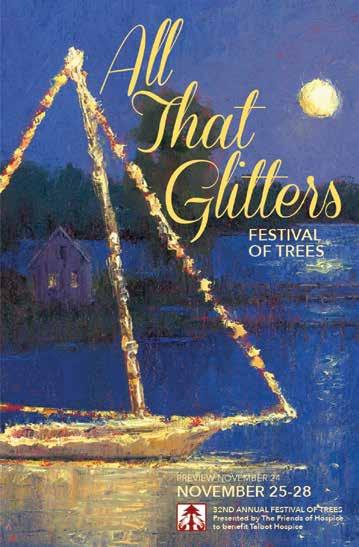
The Gold Ballroom of The Historic Tidewater Inn Easton, MD
Presented by the Friends of Hospice to benefit Talbot Hospice. Join your family and friends in awinter wonderland of beautifully trimmed trees and holiday decor
Friday November 24
Saturday November 25
Sunday November 26
Monday November 27
Tuesday November 28
Admission To The Gold Ballroom
$5 for adults, $4 for seniors 62 and older,$1for children under 12 (free for children under one).
For more info &tickets: 410-819-3378 (FEST)
Lunch at thecrab cLaw
All proceeds from your lunch at the Crab Cla win St. Michaels will benefit the Festival of Trees and Talbot Hospice. Call 410-745-2900 to make areser va tion. sunday, november 5, 11am-4 pm
Preview Party
The Festival of Trees begins on Friday with acelebratory party in the Gold Ballroom of The Tidewater Inn, cocktail reception with hors d'oeuvres, music, and special raffles. Tickets are $50 per person and include open bar from 6to 7pm and lite-fare buffet. Cash bar available after 7pm. Friday, november 24, 6-8 pm
homes tour
On this self-guided driving tour,you will visit unique and beautifully decora ted homes in Talbot County Requests for tickets by mail ($30) must be received by Nov.18. Advance in-person tickets ($30) are available until November 23 at Talbot Hospice House, and The Tidewa ter Inn Gold Ballroom from November 21 until November 23 and November 25 until noon. Day-of tickets ($35) are available only at The Tidewater Inn Gold Ballroom. Tickets are available for purchase online at www.festival-of-trees.org. saturday, november 25 & sunday, november 26, 10 am-4 pm Tickets may be used either day
candycane Lane
Crafts, games, food, visits with Santa, and other fun activities. Easton Elementar y School (Moton). Admission: Children $5, includes lunch; Adults Free. saturday, november 25, 10 am-2 pm
mother~son dance
At the American Legion Post 70, in Easton, silent auction items, photo booth, light refreshments and dancing. Music by DJ TimBurns. $30 for Mothers; $10 for each Son. saturday, november 25, 6-8 pm
daddy~daughter dance
Elk’sLodge Easton, American Girl Doll raffle, gift shop for daughters to shop for Christmas gifts. Light refreshments and dancing. Music by DJ Erik Higgins. $30 for Daddies; $10 for each Daughter. saturday, november 25, 6-8 pm
christmas eLves shoP
This is aperfect place to start your holiday shopping. The Shop is loca ted at The Tidewa ter Inn Gold Ballroom. Open during Festival hours.



in Historic Easton, Mar yland
NOVEMBER 10,11, 12,2017
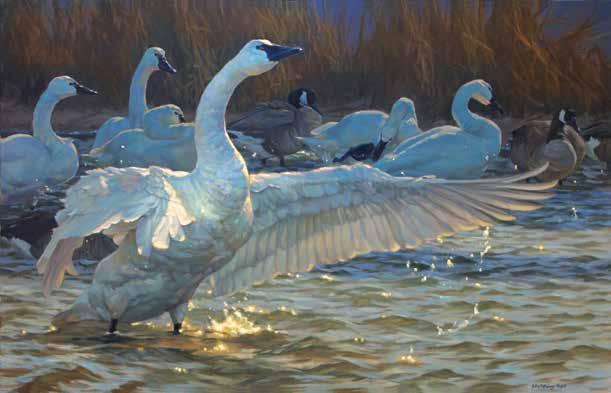


3-DAY TICKETS ARE $15BEFORE NOVEMBER 1!
$20 from November 1–12
Forticketsand moreinformation, WaterfowlFestival.org or 410-822-4567.
•Natureand sporting art: paintings, sculpture, carvingand photography
•All thingssporting—artifacts,decoys, gadgets and gear
•Retrieverand Birds of Prey Demonstrations, Dock Dogs®
•Regionalmusic,food, wine and beer tasting
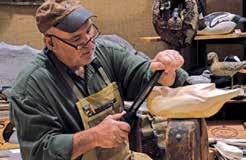
Thursday,November 9
Ar t• Coc ktails •Cuisine •Conservation
VIP Packages Available

All Festival proceeds benefit WaterfowlChesapeake’s restoration and conser vation effor ts in the region
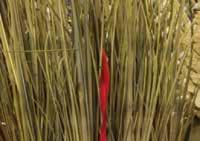
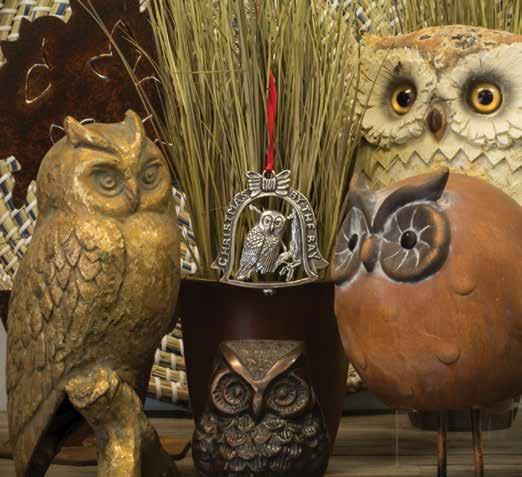










A delectable take on the local game fish; paired with wild mushrooms, rainbow swiss chard, and crispy prosciutto ham






ROCKFISH:
4 5 ounce rockfish filets (skin on)
3 Tablespoons olive oil
Kosher salt and pepper
Season the rockfish and score the skin. Season with Kosher salt and pepper.
Preheat a nonstick frying pan, then add the olive oil. Cook skin side down until crispy, approximately three to four minutes.
FALL VEGETABLES:
2 Tablespoons olive oil
2 Tablespoons diced shallot
1 clove chopped garlic
1 ½ cups trimmed farmers market wild mushrooms
2 bunches rainbow swiss chard (leaves only)
4 slices butternut squash (from the neck of the butternut squash, each sliced ½-inch thick)
4 Tablespoons maple syrup
Sauté the trimmed farmers market wild mushrooms in olive oil, then add the shallot, garlic, and rainbow swiss chard. Season with salt and cracked black pepper. Cook for one to two minutes.
Preheat a sauté pan, then add the olive oil. Season the sliced butternut squash with salt and pepper. Sauté for one minute, then add the maple syrup and cook for another minute.
CRISPY PROSCIUTTO:
4 slices prosciutto ham
Bake the slices of prosciutto ham on parchment paper at 350F until crispy, about five to 10 minutes
HERB AND OLIVE OIL CRUSHED POTATOES:
1 pound chopped red bliss potatoes
6 Tablespoons olive oil
2 Tablespoons mixed herbs (rosemary, chives, parsley) Kosher salt and pepper, to taste
Cook the red bliss potatoes in lightly salted water, about 15 minutes. Drain well, then mix in the olive oil, herbs, salt, and pepper.
FIVE ONION SAUCE:
1 small red and yellow onion, both peeled and sliced 1 shallot, sliced
2 cloves garlic, sliced ½ leek, sliced and washed
3 Tablespoons olive oil
½ teaspoon chopped thyme ½ bay leaf
½ cup white wine
1 pint water
1 Tablespoon soy sauce
Gently cook the five different onions in olive oil until soft. Add the white wine, thyme and bay leaf, and cook until most of the liquid has reduced. Add the water, and cook onions until soft.
Place cooked onions in a blender, and mix until smooth. Finish with the soy sauce and ground black pepper.
GARNISH:
½ cup cooked Brussels sprouts leaves
From 1993 to 2010, Chef Mark Salter was executive chef of The Inn at Perry Cabin in St Michaels. In 2010, he became the executive chef of The Robert Morris Inn, 314 N. Morris St., Oxford, which reopened that same year. Salter also is the proud owner of Salter’s Chesapeake Gourmet, and he represents the National Pork Producers Council and National Pork Board on a yearly basis. He can be found at two local farmers markets throughout the year. For more information, visit www.robertmorrisinn.com or call 410-226-5111.

Aerial yoga uses the support of an aerial hammock, which allows you to gently deepen into stretches, to maintain proper alignment naturally, and to reap the benefits of inversions without strain on the joints of the body. Aerial yoga uses a soft nylon fabric hammock sized to each student and suspended a few feet off the ground. It is used as a prop to access alignment, relax tight muscles, and ease stiff joints. Aerial yoga is accessible to everyone — and fun. There are several classes available at The Studio in St. Michaels for several skill levels and needs. Contact Paulette Florio at 410-924-2443 to reserve a hammock.
AERIAL YOGA at The Studio
933 S. Talbot St., unit 14, St. Michaels www.stmichaelsstudio.com
Beginner Aerial Yoga: Learn the basic poses and decompress your spine and joints with easy inversions. No yoga experience required.
Time: 6 to 7 p.m. Mondays and 11 a.m. to noon Saturdays
Cost: $20/drop-in or five classes for $75
Instructors: Paulette Florio and Carole Derry
Intermediate Aerial Yoga: Focuses on arm and core strengthening while exploring more advanced poses. For the experienced aerial student.
Time: 8 to 9 a.m. Wednesdays
Pricing: $20 drop-in or five classes for $75
Instructor: Paulette Florio
Aerial Stretch: Discover the deeper release you can achieve using the aerial hammock to stretch tight muscles and open stiff joints. No yoga experience required.
Time: 8 to 9 a.m. Fridays and 11 a.m. to noon Sundays
Cost: $20 drop-in or five classes for $75
Instructor: Paulette Florio and Carole Derry
Healthy Back Class: Relax, renew, and decompress your spine to relieve aches and pains using the aerial hammock for support. All levels welcome. No yoga experience required.
Time: 8 to 9 a.m. Tuesdays
Cost: $20 drop-in or five classes for $75
Instructor: Paulette Florio

Recently appointed Church Hill Theatre Director Hester Sachse talks about her love of the arts, and how theater can help make the world a better place
Story by Sarah Ensor | Photos by Caroline Phillips
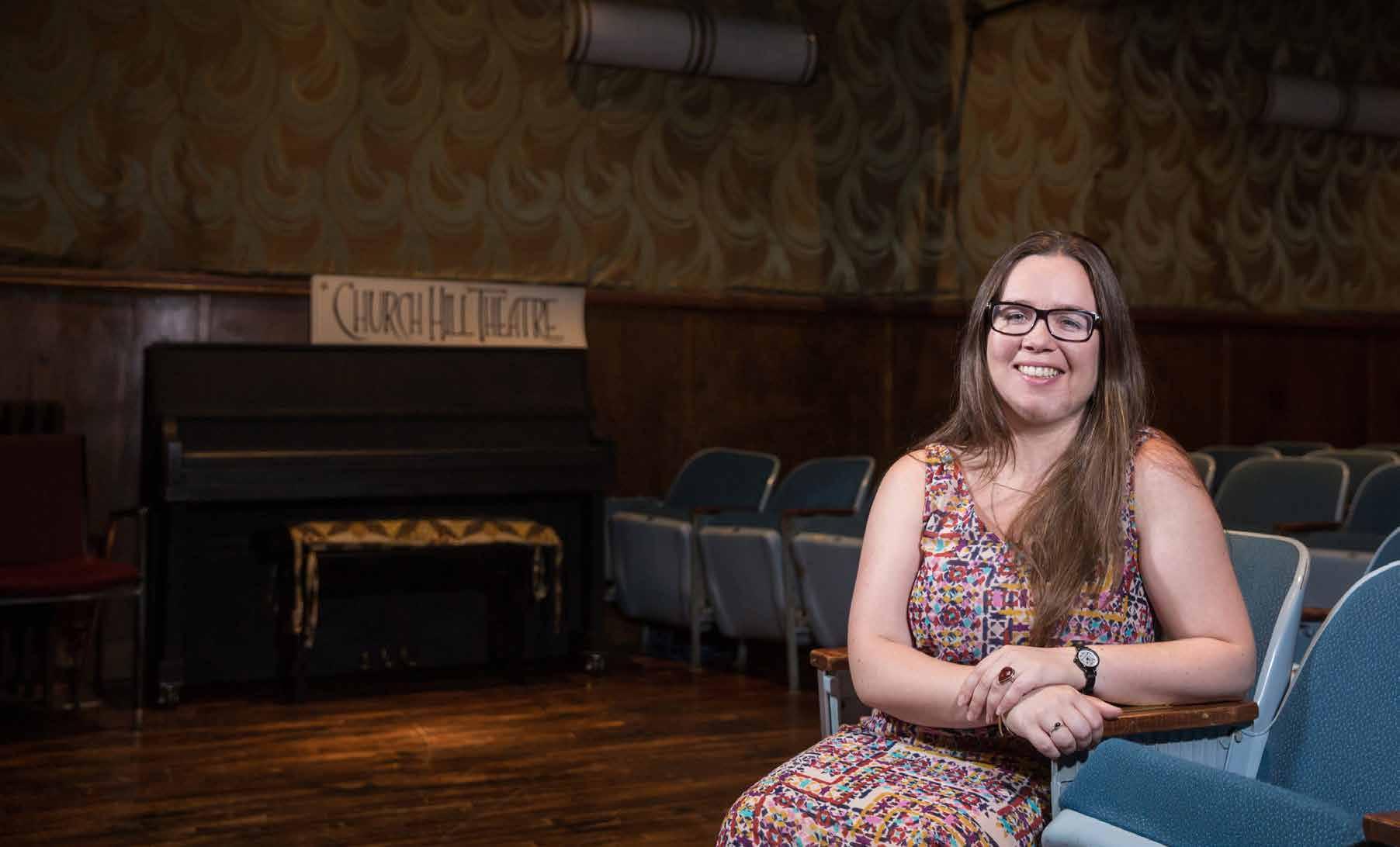


Hester Sachse, 31, the new director of the Church Hill Theatre, loves to talk about plays and hopes theater audiences will, too.
“It’s been really great that ‘Doubt’ (‘: A Parable’) has been my first show here,” Sachse said. “… It’s one I’d read in college because it was the thesis of another senior in my year, and I’d seen it done then. And I think it’s a really important piece of theater.”
Each performance featured a post-show discussion about the play, and the dramaturgy website, http://doubt.churchhilltheatre.org, encouraged audience members to discuss the play outside the theater, offering robust information, and offers questions to deepen the viewer’s understanding. It offers a great deal more information than is possible in a program.
The discussions, or “talkbacks,” were well attended, and Sachse witnessed what she considered to be important conversations.
One of Sachse’s goals for her tenure is to increase the educational offerings through the theater. Education often is viewed as something only for youth theater, she said, but education can enrich the theater experience for adults, as well. Incorporating discussions with the performance of every show might be impractical (“Doubt” only

ran 90 minutes) because it could be too much to ask of audiences, actors, and crew members to stick around after a long play. But more dramaturgy websites could be in the theater’s future if they prove to be of interest to audiences. Sachse said she also would love to create a book club-style group — except for plays.
“I don’t want the theater to just live in this room,” Sachse said. “I think it should be outside of this space.”
Last summer, the theater opened the Zierfus Space. About a half-block from the Church Hill Theatre, the rented greenroom-like space offered a place for the Green Room Gang, the theater’s summer camp, to rehearse. In the future, it could be used for rehearsal space for other productions, or perhaps as an auxiliary theater space. A new local actors group has held its first meeting there.

The theater is nearly 90 years old and in need of renovations. A $10,000 grant from Preservation Maryland will help with the $19,000 needed to restore the stucco on the front of the building, and the theater has been challenged with raising the additional $9,000.
“It’s really wonderful having a beautiful historic building, but with that comes its own foibles,” Sachse said. “This project is definitely going a long way to preserving the longevity for us to provide theater to the Eastern Shore.”
The stucco project is the first step toward ensuring the theater will continue to stand, but there are more renovations needed.
Sachse’s commitment to keeping the theater vibrant is in line with her vision of community theater — an outlet for making the world a better place.
A 2009 alumna of the Washington College Drama Department, Sachse didn’t always plan to make a career out of her appreciation for theater. She entered college intending to major in political science and/or international studies.
She wasn’t as interested in the subject matter as she had planned. However, she was excited by the freshman writing course she took. In class, they discussed, thought about, watched, and wrote about plays.
It wasn’t long before she declared drama her major. She held onto that philosophy of making the world a better place as she developed a passion for community theater. She said she enjoys how community theater gives her access to the people that her work affects more than at, say, a political think tank.
Sachse’s stage experience started in second grade, when she played Grandfather Fox in a staged version of “Aesop’s Fables.” In 2001, she came out of retirement during her freshman year of high school to play Mrs. Webb in “Our Town.”
She stayed involved with drama throughout her time in high school at Oakwood Friends School in Poughkeepsie, N.Y.
When she arrived in Chestertown to attend Washington College, she got involved at The Garfield Center for the Arts at the Prince Theatre because Lucia Foster, who then worked there, also had worked at Oakwood Friends.
Sachse started helping with the Playmakers summer camp at the Garfield, as well as with the Green Room Gang at Church Hill Theatre.
After graduation, Sachse left Chestertown and worked at Oakwood Friends School as a substitute drama teacher, nanny, and dorm parent. She once again found herself on stage at Oakwood, wearing the same costume she wore as Mrs. Webb, when a student fell ill and she had to fill a part in “The Man Who Came to Dinner.”
She later returned to Chestertown to work with the Playmakers, and stayed for a year. When her father, Bryan, fell ill, she moved with him to New York City as he worked to regain his health.















I don’t want the theater to just live in this room,” Sachse said. “I think it should be outside of this space.

While there, the Sachses took advantage of their access to theater and live music. They had always been fans, and Sachse had been going to the Metropolitan Opera since she was 8.
Her father’s health improved and Sachse realized she missed the community of a small town. In 2015, moved back to Chestertown when Diane Landskroener, who was directing “Enchanted April,” was looking for help.
Sachse said she feels at home in the strong communities of Chestertown, Church Hill, and Centreville. There is a sense of building a bigger and better place — something that resonates with her life philosophy, she said.
She continues to work at Chester River Wine and Cheese Shop in her off time, partially to keep her feet in Chestertown while she expands
her personal community to Church Hill.
“Now that I’m coming in and sort of jumping in, (I’m) kind of belly flopping a little bit … because it’s with great enthusiasm, but not necessarily with a whole lot of grace,” Sachse said.
She said she is learning a lot from the board of directors, from outgoing director Nina Sharp, and from Liz Clarke, administrative assistant for the theater, who all have been supportive during her transition.
“This is also hard work, but it’s hard work doing something that I really care about,” Sachse said. “And I think that makes a huge difference in that it helps me find the energy to do a lot more outside of here I think, which is good.”
” S


Learning how to fire a gun can be an intimidating proposition for the uninitiated. Greg Sharp shares how to show a novice the ropes.
Story and photos by Greg Sharp
It’s been a little more than a year since taking up with my lady, Kim Hopkins. As with any healthy relationship, we’ve spent a lot of time sharing the things that we find important, life affirming, fun, and serious — and the hobbies we have a passion for.
On my side of the ledger, some of what I’ve been sharing is my lifelong love of everything outdoors — wildlife photography, hunting, fishing, and so on. Turns out, she had an interest in learning about the safe handling and proper use of firearms prior to our meeting. However, her interest was geared more toward home defense and personal protection.
After accompanying me on some of my hunting adventures, though, she’s become keen on learning how to get into hunting, as well. These are two projects I’ve more than happily embraced.
During the course of the past several years, and for a variety of reasons, I’ve found myself hunting with my camera more than with a gun or a bow in hand. This process of helping Kim along the hunting path has breathed new energy into me re-engaging in what had been a very important, healthy part of my life.



or learning how to defend hearth and home — are skill sets that are challenging, fun, and rewarding ... and in the case of defending one’s self and loved ones — empowering. I don’t know anyone who embraces the notion of themselves or their loved ones being victims.
Furthermore, firearm education and safety is essential should one decide to pursue the sport of hunting. As a lifelong participant in the shooting sports, having taken the National Rifle Association’s firearm safety course and hunter’s safety course, I was well equipped to help teach Kim. She also has taken the Maryland hunter’s safety course, as well.
I’ve also provided her with outside literature. For someone without a mentor to help them, the NRA’s website has links for firearm education and safety literature, as well as coursework.
Another handy option is the hunter’s safety course available on the Maryland Department of Natural Resources’ website. It’s a valid exercise and training course, even if you have no intention of going on to learn to hunt, and it is a requirement if you do intend to hunt in Maryland. An internet search also can direct those interested in learning how to properly handle and shoot firearms to gun ranges and training programs.
Finally, for parents who would like their children to have firearm training, there’s some wonderful marksmanship programs available through some 4-H organizations.
Part of our process has included “Funday Gunday” get-togethers with friends and family, including Kim’s daughters, Patti McQuay and Ashley Hopkins. The gals have shot a wide variety of guns, including big bore, muzzle loading and .22 caliber rifles, semi automatic and pump shotguns, and a couple of pistols.
Newcomers invariably have some trepidation about recoil, or, the backward
momentum of the gun after the force of firing a shot. The guns we’ve practiced with have ranged from virtually no recoil to substantial recoil. In fact, Kim and Ashley were chaffing to experience what a real thump felt like, which I thought was rather sporting of them.
The best I could provide was a very healthy 3 ½-inch “Turkey Load” out of my 12-gauge semi-automatic shotguns. They both took their shots from a standing position and sported huge grins after touching off the shot … big fun!
For honing their skills with the rifle and pistol, we’ve been shooting at stationary targets using .22 caliber rifles and a .22 caliber pistol. They both have low to no recoil and are inexpensive to shoot (which is a real plus). One only improves skills with practice, so it’s good to have the ability to shoot a lot without breaking the bank. For fun, I’ve included “spinner” and “gong” targets, which give the shooter some grin-producing positive feedback when hit.
While learning about shotguns, we’ve gone over their essential differences with rifles by shooting at stationary targets and clay birds in flight.
Ashley’s original interest was more along the lines of learning how to safely operate and take care of the shotgun that her beloved, late father left her, but now she enjoys the fun of shooting all the guns. She has no interest in hunting, which is fine, as it’s not for everyone, but she’s up for a “funday” or “triggerfest” anytime.
Kim, on the other hand, after sharing in some exciting and successful hunts for squirrels and deer last season, is on the fast track to learning about animal habits, biology, anatomy, and the fieldcraft required to prepare herself to be able to ethically and humanely “make meat” if she chooses to do so.
Perhaps a tale to be told later ... S
For Ashley and Kim Hopkins, the process of learning to shoot a gun began with firearm safety. Newcomers may have some trepidation about recoil, or, the backward momentum of the gun after the force of firing a shot, but Ashley and Kim were itching to experience what a real thump felt like.
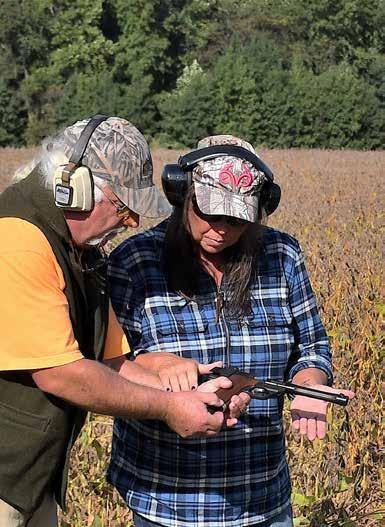
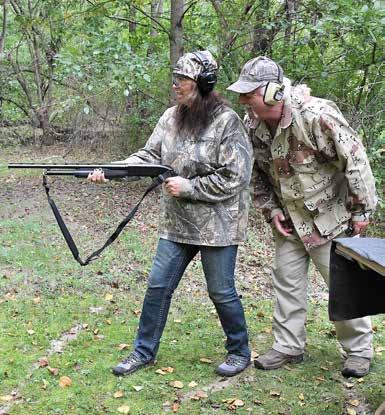

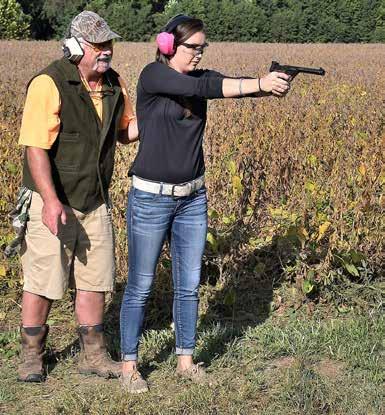
Baltimore’s Charm City Meadworks is on a mission to bring mead into the spotlight
Story by Josh Bollinger
Photos by Henley Moore
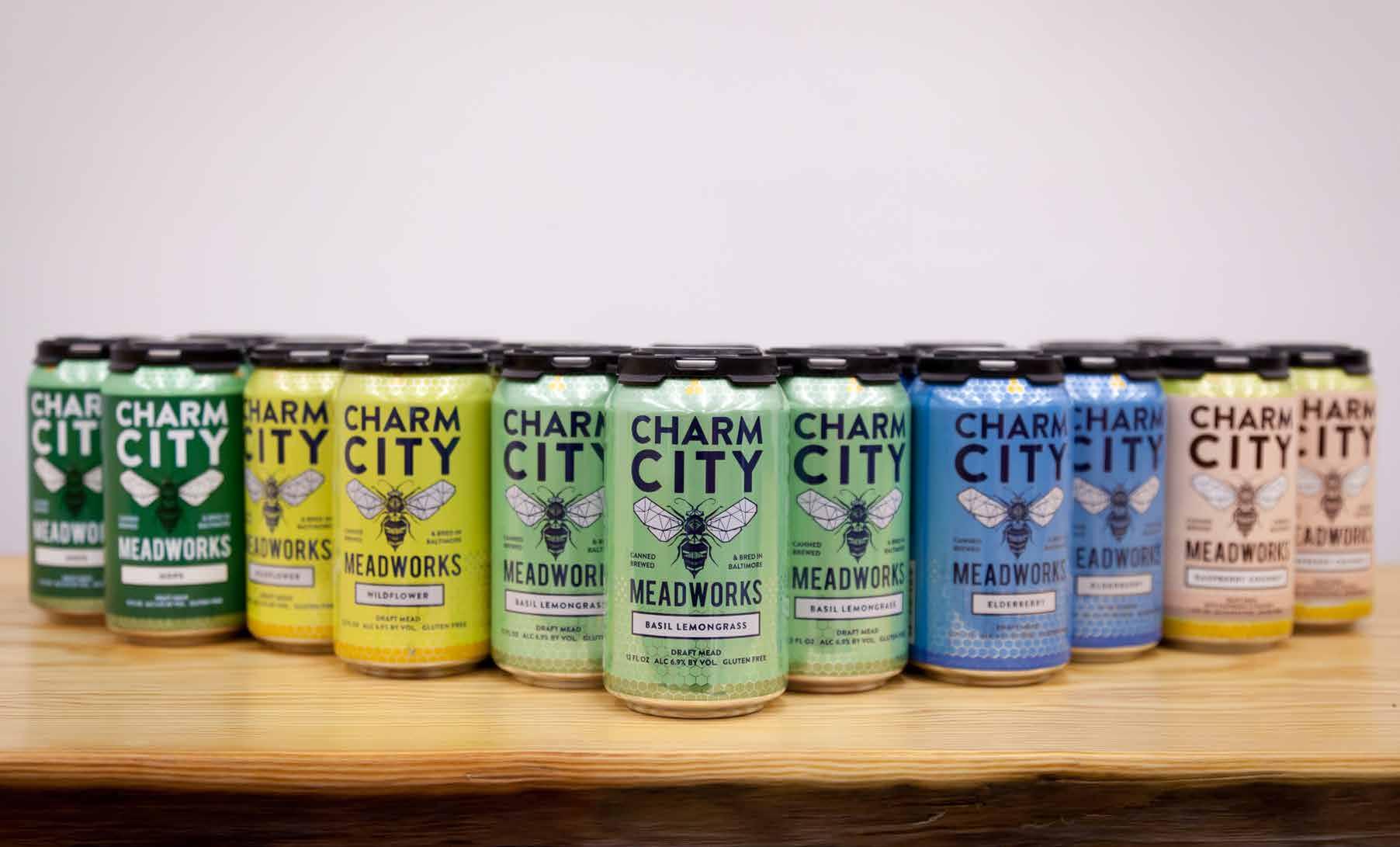

“It’s crazy the growth that we’ve gone through, and it wouldn’t be unless people are really drinking it,” said Charm City Meadworks co-owner James Boicourt, formerly of Trappe, but who now lives in Baltimore.
Mead is a versatile beverage, Boicourt said. On the taste spectrum, it sits somewhere between cider, beer, and wine. It is an ancient drink, sometimes referred to as the “nectar of the gods.” The main ingredient is honey, and it becomes alcoholic after mixing it with water and fermenting it with yeast.
Boicourt took a beekeeping class in college, where he was treated to a mead-making demonstration. After his hives produced more honey than expected, he decided to try his hand at making mead. He later met Andrew Geffken, co-owner of Charm City Meadworks, while working at the Chesapeake Bay Maritime Museum in St. Michaels, and the two brew enthusiasts started a hobby making mead that quickly turned into a business. Baltimore’s only meadery officially launched in 2014.
A lot of the meads on the market during the past 10 years have been of the heavier, sweeter variety, Boicourt said. Charm City Meadworks’ product is dryer and lighter.
“We’re trying to take it somewhere we see in other parts of the world, as it has been historically, like an everyday kind of bever age,” he said.
And people have embraced it, too.


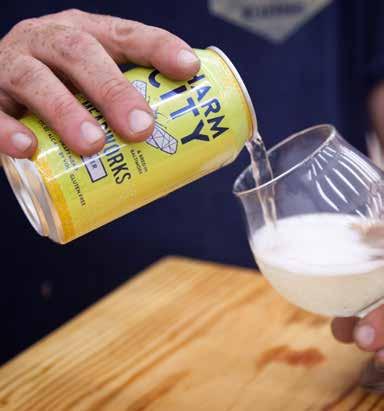
“Before we started, you could have asked a lot of people and they would have had no idea what mead was — most anybody — and we’ve gone from that to being a household name, where people understand what the product is and they’re excited about it,” Boicourt said.
For Boicourt, experimenting and innovating is what leads to creating a product that people really love.
The meadery has a growing list of seasonal and regular products, and product development remains an important aspect of the business, Boicourt said. It is a bit of an experiment, although they have ideas and visions for what tastes they would like to incorporate into their beverages, but at this point it is some “educated guesses,” he said. Charm City Meadworks moved production in January to a
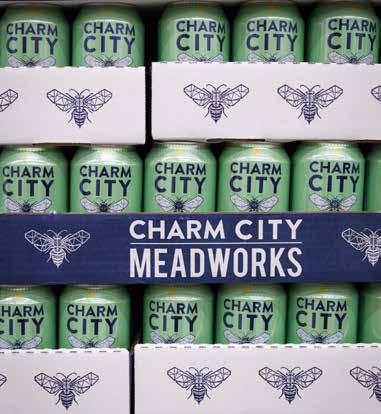








larger facility in Baltimore.
“Which, to be honest, we’re already outgrowing,” he said.
They’re also working on getting a taproom open in Baltimore. Boicourt wants to see an expanded market place for his business.
Currently, people can find Charm City Meadworks’ beverages in restaurants and bottle shops in Maryland, Northern Virginia and Washington, D.C.
“We’ve only barely hit the Eastern Shore (of Maryland), and we haven’t made it down to the (Ocean City) beach,” he said.
Charm City Meadworks still is a young company.

“Given the amount of money we started with and the amount we were producing when we first started, I think it’s a shocking amount of change,” Boicourt said.
“Most breweries and wineries, you need to kind of reach a critical mass before it becomes something that’s really sustainable as a business,” Boicourt said. “Over the next year, as we open our taproom, I’d like to become more involved and engaged in our community.”
people who are versatile and strong members of the team. It takes a team of people to do a larger distribution effort and to grow a business. And that team of people has to have really strong members who can take ownership and who really understand all the little bits and pieces of their job, because that’s what allows a company to really grow.”
Because it’s a young company with consistent growth, Boicourt said it’s important that he and his staff “have a firm grip” on what people want — from quality control, to relationships with customers, to the soon-to-be taproom, and in production — “every little detail
So where’s the proof for Boicourt of Charm City Meadworks’ success?
“It’ll be interesting to see what happens as we go into new territories and newer markets, but I think people are really catching on.”
What makes it all work is Charm City Meadworks’ staff, Boicourt said.
“They’re what makes it go forward. These days, I can help, but it’s a team effort, and without the people that are part of that team, we couldn’t do any of it,” he said. “You can buy extra warehouse space, you can buy more equipment, hire more employees, but having
Boicourt told a story of a friend who sent him a photo one day of one of the meadery’s cans crushed and lying in a gutter.
“And they said, ‘You made it,’ and they were kind of right. When it becomes something as ubiquitous in people’s lives as that, it shows you’ve become something. I like to hope that, with our customers, that it rolled out of a recycling bin, but that means people are drinking the stuff every day, and we see that with our shelf turnover,” Boicourt said.
“It’ll be interesting to see what happens as we go into new territories and newer markets, but I think people are really catching on,” he said, adding that for something that started in a kitchen, it’s pretty exciting to watch it all happen.















For these Eastern Shore families, hunting is not a hobby or sport, but a tradition passed down through generations — a way of life.
Story by Denae Spiering



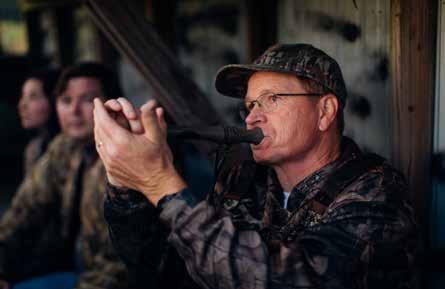



The Eastern Shore is a wonderland for any outdoorsman and their family. From the rolling brackish rivers to the tree-lined acres of lush farm land, the Shore provides hunters with a paradise for waterfowl, turkey, or deer. But for five Mid-Shore families, being able to wait out their earthly opponent boils down to much more than the thrill of the hunt.
Hunting on the Mid-Shore is steeped in tradition, togetherness, and conservation, and nobody understands those benefits more than the Watermans of Queen Anne’s county.
Reen Waterman of Stevensville said his family is passionate about the outdoors. He said that passion began with his late father, Mareen Waterman, whose claim to fame was being able to shoot four of the “Big Five of Africa” — the lion, leopard, rhinoceros, elephant, and Cape buffalo.
“He was the original Tarzan,” Reen Waterman said of his father. “Like him, I have shot exotic animals, like crocodile, but still my passion is to be here on the Eastern Shore, hunting deer.”
Mareen Waterman moved his family to the area in 1969 from Annapolis, and their passion and love for hunting on the Shore not only developed, but blossomed into life lessons, unbreakable bonds, and remarkable stories.
Reen Waterman said his father fell in love with the Eastern Shore and bought his dream home, a 200-acre dairy farm in Queenstown, complete with a farmhouse, on the water.
“My mom knew how important it was to him,” Reen Waterman said. “And she understood the value it would instill in us kids.”
While his father did not continue the property as a dairy farm, he did develop it into quite the hunter’s retreat.
“It became a gentlemen’s farm,” Reen Waterman said. “He installed ponds and duck blinds, and hedgerows.”
The “gentlemen’s farm” enabled the Waterman family to hunt a variety of critters, including quail, rabbit, dove, ducks, and geese, and to learn valuable skills and lessons, as well.
“We did all kinds of stuff, back before the days of Bass Pro Shops,” Reen Waterman said. “We made our own decoys out of old tires, and we learned a lot of practical and mechanical skills, and the importance of conservation.”
Waterman said his father stressed the importance of conservation. He said his father told him and his brother, Barry, that if they were going to kill something, they had to eat it.
“That is not something we take lightly,” Reen Waterman said. “Lots of hunters are the greatest conservationists. There is a lot of heart that goes into it, there is a lot of value of being in nature and being outdoors. God made all of this, and it is beautiful and it is our job to preserve it.”
Reen Waterman said the connections
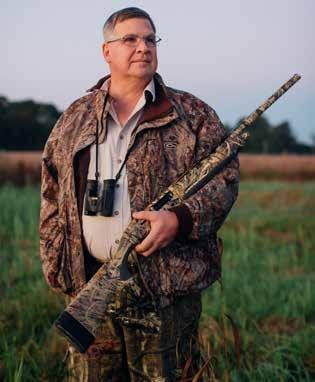

he and his brother have made with others also drives their love of hunting.
“Some of the best time is spent in the woods without even firing a gun,” Reen Waterman said. “For us, it is about getting kids outdoors, whether it is fishing, skeet shooting, or hunting, being able to pass on those values and spend true quality time — that is what it is really about.”
That bonding time with children is what motivates the Tribbetts of Caroline County to don the camouflage and play the waiting game with furry and feathered rivals.
David Tribbett said what makes his family unique is that his hunting traditions and those of his grandfather are being passed down to his daughters.
“We are the same as any other hunting family on the Mid-Shore, really,” Tribbett said. “The only difference is, I have daughters.”
It is that special daddy-daughter time that Tribbett said he relishes in, and maintains, to keep his family’s traditions alive.
“I see it as the opportunity to get to
spend more time together,” Tribbett said. “It is not about the hunting really, it is about the time we spend hunting.”
The Tribbetts’ hunting traditions began in Pocomoke with Tribbett’s grandfather, and have been continued on by his father, and now him.
“When I was 10 years old, my grandfather gave me my first .410,” Tribbett said. “That was a tradition that my dad has continued, and when my girls reached 10, he got them all their first .410s.”
Tribbett has three daughters; Taylor, 12, Calleigh, 11, and Camdyn, 7. All the girls hunt for dove, deer, and waterfowl.
It is that family connection that Tribbett said keeps the traditions alive and helps him to create everlasting bonds with his little girls.
“I don’t like shopping, that is something they do with their mother,” Tribbett said. “But hunting is my time, it’s that nice one-on-one time. It is wonderful because it is just our time together — no distractions, no cell phones, or TVs. Just daddy-daughter time.”
began hunting as a kid with his family and enjoys teaching his girls the tradition. Camdyn Tribbett, 7, hunts with her dad and sisters on their farm. Camdyn shoots with a pink camo BB gun. Spring and David Tribbett, and three of their daughters, Taylor (left), Camdyn, and Calleigh, pose in front of their barn in Ridgely. Photos by Allison Zaucha.

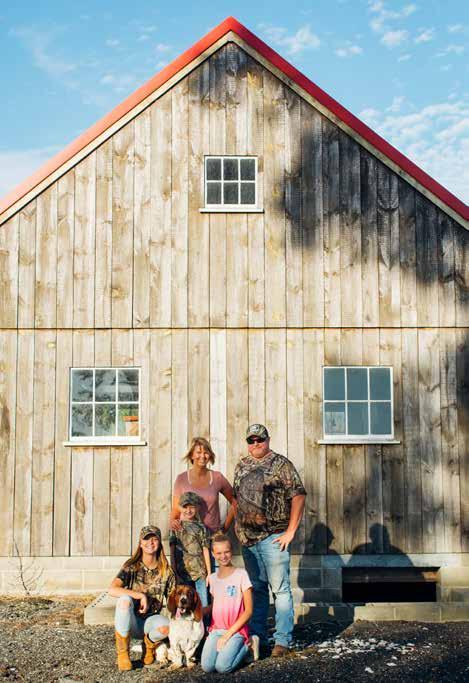

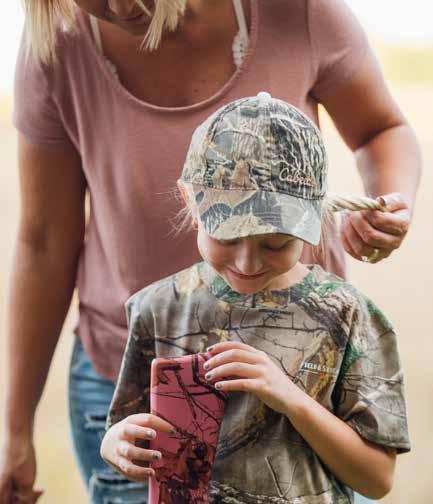
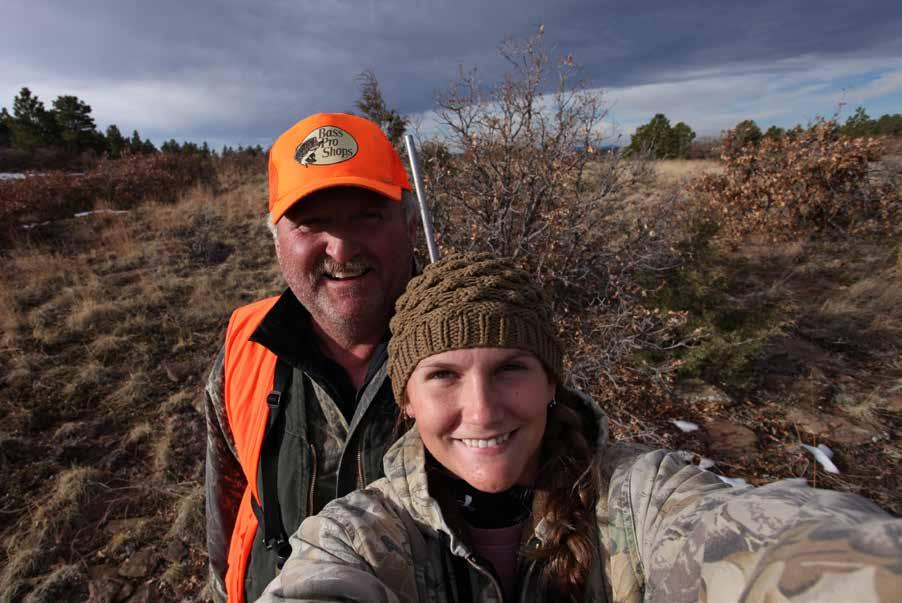
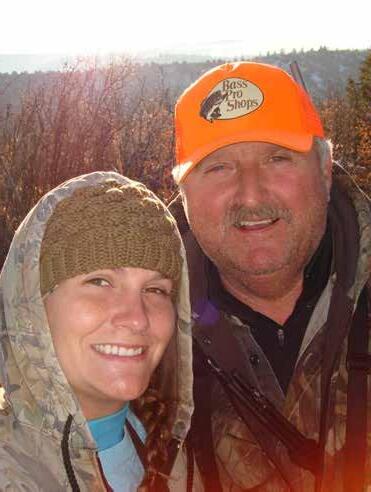
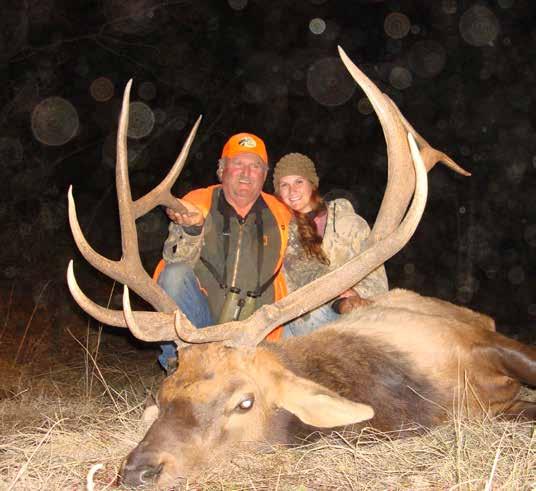

He said the time they spend in the blinds and preparing for the hunt gives him the opportunity to talk about life and to “just hang out.”
“Prepping stands, putting out corn, brushing the blinds — that is all time I get with them,” Tribbett said.
To encourage his daughters’ interest, he installed and maintains a Duck’s Unlimited Pond on his farm — Twin Maple in Ridgely.
“Once I seen they had an interest, I had to put it in, ” Tribbett said.
In addition to the pond, Tribbett has conducted a guided dove hunt annually on his farm, where people come from all over the country to participate.
He said he loves how times have changed with regard to women hunting, and that his girls are fantastic marksmen.
“It’s weird, it’s not the way it used to be,” Tribbett said. “But to be honest, my girls can do anything a boy can do, from driving a tractor, to hunting. It’s incredible.”
The daddy-daughter theme is one that continues with the Jones-Hardy family in Dorchester County and the Kennedys in Talbot County.
Coty Jones-Hardy grew up hunting around Hoopers Island as her father, Phillip Jones’, “li’l side kick.” She said she was around 12 when she shot her first deer, and hunting is a big part of who she is.
“I was always a tomboy, always outside,” Jones-Hardy said. “I was never into girly things, and for me it was great, because dad and I got to spend a lot of time together.”
Jones-Hardy said the time she gets with her father is time she cherishes.
“I don’t think people take the time to spend with their parents that they should,” Jones-Hardy said. “I loved growing up the way I did, and I still love being with him and spending that time with him.”

Together, she and her father have hunted sika deer in Dorchester County, elk in the Midwest, and black bear on the western shore, for which she holds the state record in Maryland.
“I got a bear and it was my first time,” Jones-Hardy said. “I thought, ‘well that looks like a nice bear,’ I couldn’t really judge its size.”
She said her bear weighed in at 615 pounds, surpassing the previous record holder by 125 pounds. She said she and father brought the bear back home, where they shared the meat with family and friends, and had a full body mount done, which currently is in her parents’ game room.
Bringing the meat home to share with friends and family is something JonesHardy stressed is important.
“We do not waste anything,” JonesHardy said. “That animal made a sacrifice, and we honor that. We make sure to eat everything we harvest.”
Jones-Hardy has a 2-year-old son, Leland, and she is pregnant with her second child, both of which she said she will be sure to carry on the hunting traditions with.
Carrying on those traditions is something that is important to Megan Kennedy and her father, David Fisher.
Like Jones-Hardy, Kennedy is fond of being outside and spending that one-onone time with her dad.

“I really enjoyed the outdoors, just being in the house wasn’t for me,” Kennedy said. “My dad was always passionate about hunting. He started taking me when I was about 4 or 5 years old.”
She said those trips led to a lifetime of togetherness that means the world to her.
“Being out there with him — just him and I — just getting together means a lot to me,” Kennedy said.
When she was about 10, her father took her to a hunter’s safety class. She said he stressed safety and respect for animals, and how hunting is important to society with regard to conservation.
“He made sure I understood safety and what it meant to kill an animal,” Kennedy said. “The knowledge to kill — that we don’t kill for fun, but for food for our family.”
“I was about 10 or 11 when I shot my first deer,” Kennedy said. “When Dad walked up, he said I had to learn how to do it on my own — gut it, clean it, everything. It was a choice I made, that if I wanted to do it, then I had to clean them, too.”
She said that lesson is something that has been passed down from generation
to generation. For Kennedy, hunting is something that goes beyond her and her father. Her entire family hunts; her two brothers, her husband, Cory Kennedy, and her in-laws. It’s that husband and wife hunting connection that is really special to Kennedy, she said.
“Just being together outdoors is what it is really about, and as a couple, it means a lot to us,” Megan Kennedy said. “We call it our ‘date night.’”
She said her husband proposed to her in a hunting blind.
For Megan Kennedy, like with other Mid-Shore families, hunting is a time to unplug and to make real connections with one another, and she hopes to pass that message to her 1-year-old son, Bo.
“That time together without electronics is important to me, and it is something I can teach Bo,” Megan Kennedy said. “That face-to-face time while waiting out in a blind is really important, valuable time.”
Around Thanksgiving each year, Megan Kennedy said the whole family comes together to hunt geese.








BOTTOM LEFT:
From left, Shiela, Chris and Tyler, and Brianna Pierce all have grown up in Rock Hall. The entire family hunts, although Shiela said she is too busy with Chester River Seafood Company and focuses on cooking for her family. Tyler learned to hunt with his dad when he was a young boy. At 16, Brianna is an experienced shooter, killing large deer, turkeys, and geese. Photos by Allison Zaucha.

“We try to get a goose every year. We have a family goose hunt together,” Kennedy said. “If we get one, we usually have it for Thanksgiving dinner.”
Hunting is a family affair for the Lingermans of Kent County, as well.
Chris Lingerman of Rock Hall has spent most of his life outdoors, beginning with hunting waterfowl and deer with his father, then with his own four children; Tyler Lingerman, 23; Brody Pierce, 19; Thomas Lingerman, 17; and Brianna Pierce, 16. He also works as a commercial waterman, currently diving for oysters, and owns Chester River Seafood Company in Rock Hall with his wife, Shiela.
“My dad started taking me when I was about 9 or 10 years old,” Lingerman said, “and I have always tried to keep my kids active in it, especially when they got around the same age.”
He said keeping his kids active in the right things is important to him, and the first thing he did was sign them up for their hunter’s safety course when they were eligible.
“It is important to keep them involved in hunting or sports,” Lingerman said.
“Something that is going to keep them out of trouble. It’s also a tradition for us, and it is what people on the Eastern Shore do.”
Lingerman said he grew up hunting for goose, duck, and deer on his grandfather’s farm, and now he and his children hunt on the 200 acres behind his own home.
He said the best memory he has from taking his children hunting is the moment they shot their first deer, and the competitiveness of the hunt.
“That kind of memory just sticks,” Lingerman said, “and for us, hunting is all about challenging one another — who shot the smallest or who got the big one. But really, it is all about spending time together.”
He said many of those big and small trophies, such as turkeys and deer, are mounted in his office — reminders of time well spent.
When it all boils down, hunting, no matter the game, is all about family, togetherness and preservation. Preservation not only for the animals they are hunting, but also for the traditions they are carrying on and the strength and longevity of the family, as well. S




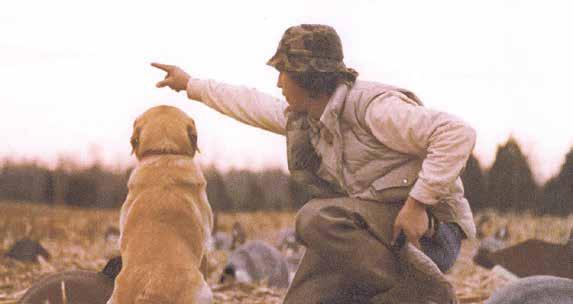














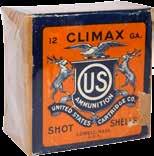








Cory and Megan Kennedy live in Trappe with their 1-year-old son, Bo, and their two black Labrador retrievers, Kane, 5, and Mia, 6 months. Cory owns and operates Kennedy Lawn Service. Megan is an employee with the Maryland Department of the Environment. Cover photo by Christopher Watson.

















